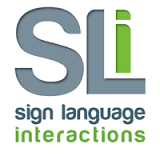
Working with BSL / English Interpreters
Working with a British Sign Language Interpreter – 10 things you should know!
If you’re working with a British Sign Language (BSL) Interpreter for the first time or it is something you’re considering, read our top tips on what to do:
1. Book in advance
Due to the demand and limited number of BSL interpreters in Scotland, giving as much notice as possible is always really helpful. There will of course be situations where this is not feasible, such as in an emergency; however in these cases our coordinator will always do their best to provide an interpreter as soon as they can. There are facilities for Online Interpreting which ables BSL users to communicate with staff while waiting for a face to face interpreter to arrive. (Check your local NHS board for Hospitals that provide online interpreting service’s)
2. Preparation
When booking an interpreter, provide as much information prior to the assignment as possible. Examples of preparation material – date, times, venue, context, people attending etc. If this isn’t possible, then contact the office to explain at least the aim of the meeting / training / appointment etc. It is important our interpreters are as prepared as possible before going into a booking as this allows the best possible service to be provided.
3. Duration of the meeting
We know sometimes appointments and meetings can over run, but it’s important to only use the time that you have booked with the interpreter as they usually have other bookings either side of the assignment. While the interpreter may be able, on occasion, to stay, it is usually not the case so booking enough time needs to be planned carefully.
4. One singer one song
During the booking, please try to ensure only one person is speaking at a time. This could be done by requesting people raise their hand if they want to speak. The interpreter is only able to sign for or voice one person at a time. You could risk important information being missed if everyone talks over each other.
5. Speed of speech
Speak in your normal tone, at your normal pace. The interpreter will tell you if you need to pause or slow down. If you use a word that the interpreter is unfamiliar with, he or she may ask you to spell it.
6. Breaks
If there is only one interpreter available/booked, they will need breaks approximately every 30 – 45 minutes. However, this depends on the content of the assignment so it’s always best to check with the interpreter or with the office when you book.
7. Reading time
If handouts or a power point presentation is being used it is impossible for the Deaf person to read the handout and watch the interpreter at the same time. Give the Deaf person a few minutes to read the information before you start adding or explaining the document.
8. Explanations
Try to avoid Acronyms, Abbreviations, Idioms and Initials as this can be hard to interpret if the meaning is not clear, so explain them as you use them. You don’t want the Deaf person to miss out on any important information.
9. Setting
The set up of the room can really help in an interpreting situation. It’s not something that people usually think about, but it’s best if the interpreter is not sat or stood against any bright lights/windows, and that they are positioned in the best place for the Deaf person to see clearly. The acoustics can also make a difference depending on the situation, so large rooms with high ceilings that echo are best to be avoided.
10. Eye contact
Finally, it is important to look at the Deaf person with whom you’re talking, rather than the interpreter. The Deaf person in this situation will be looking at the interpreter to receive information of whats being said. Often, in a one-to-one situation, the hearing person will say to the interpreter “can you tell him/her….” which can be unintentionally rude.
If there is anything else you want to know about working with an interpreter, or you have any other questions, please contact our office on 0141 419 0420 or email us on admin@signlanguageinteractions.com

